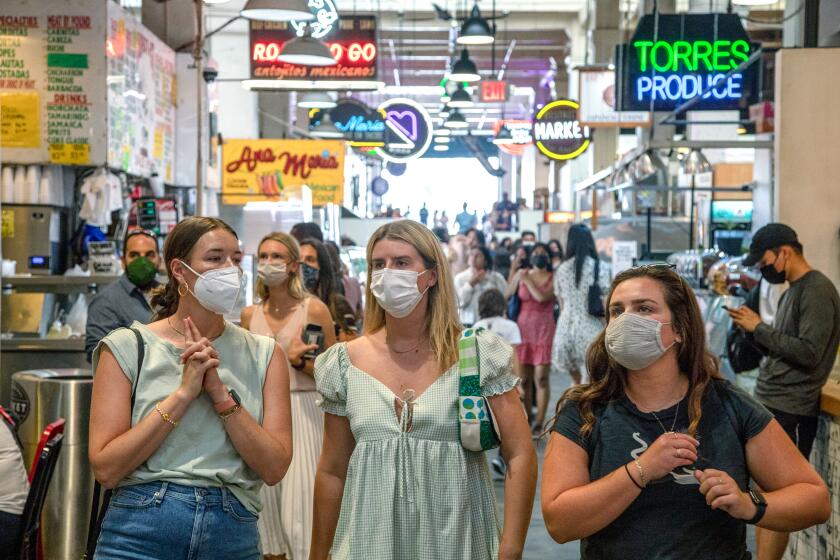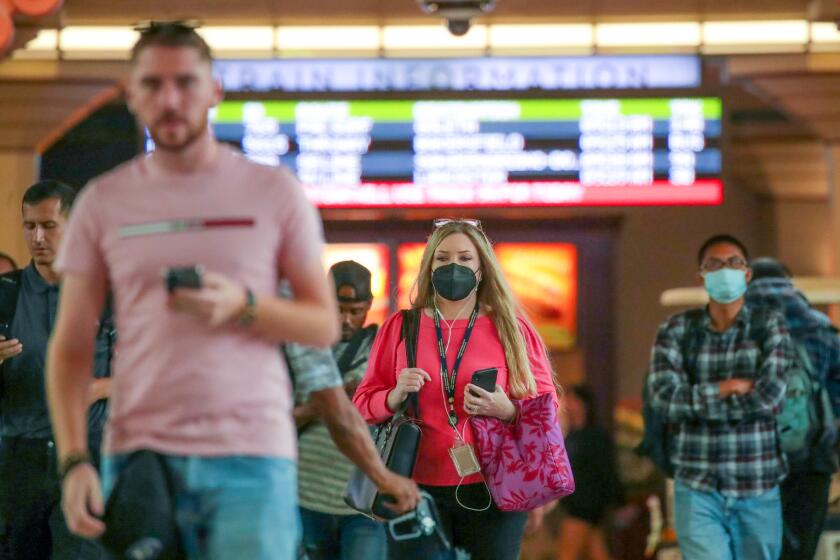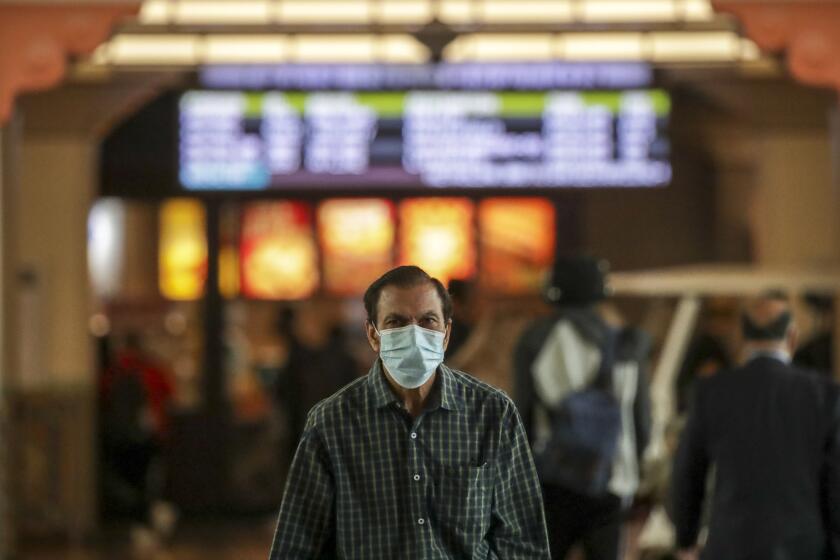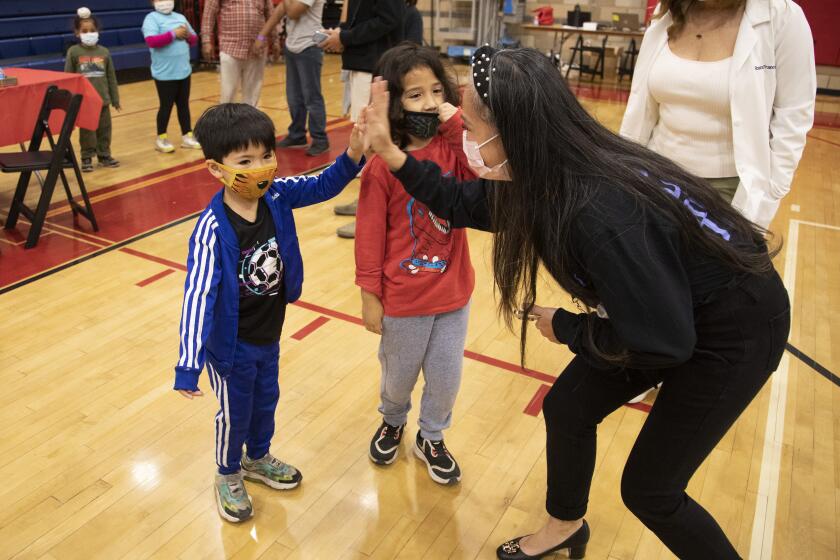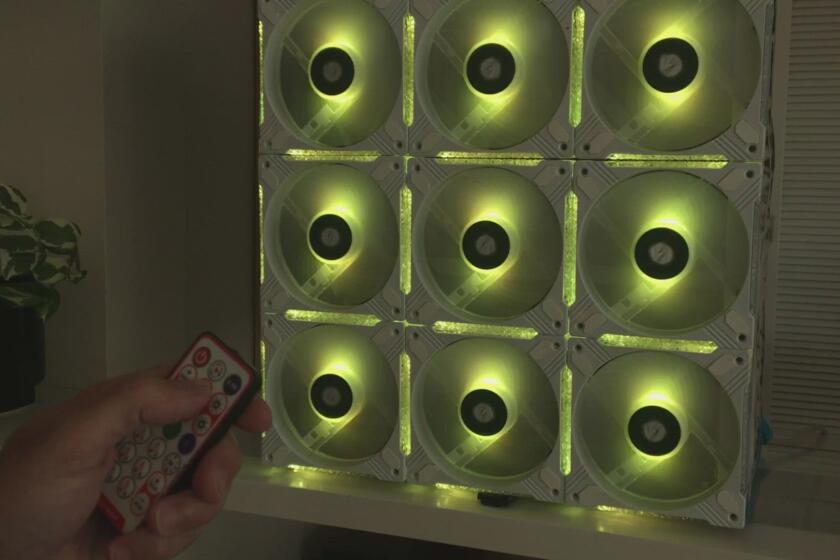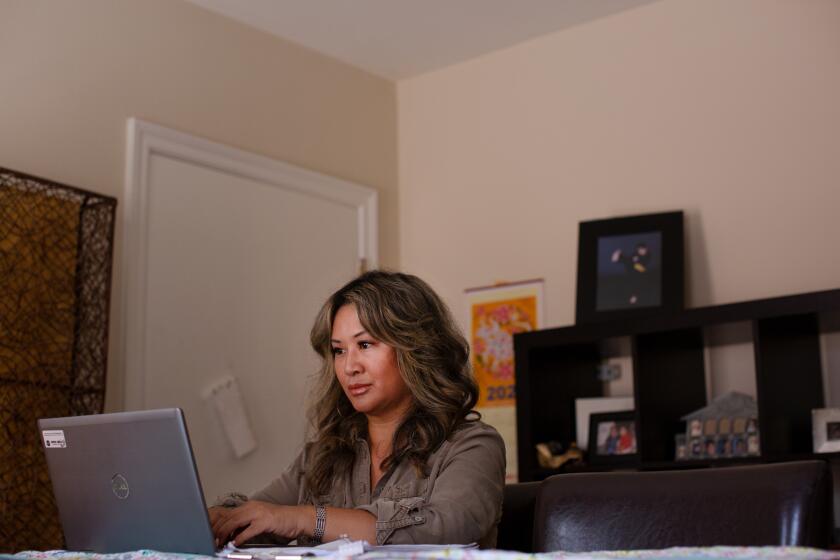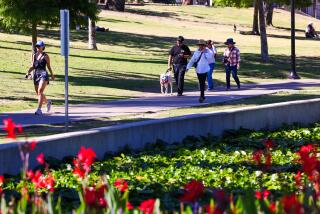L.A. COVID surge appears to be cresting, but the picture is still far from good
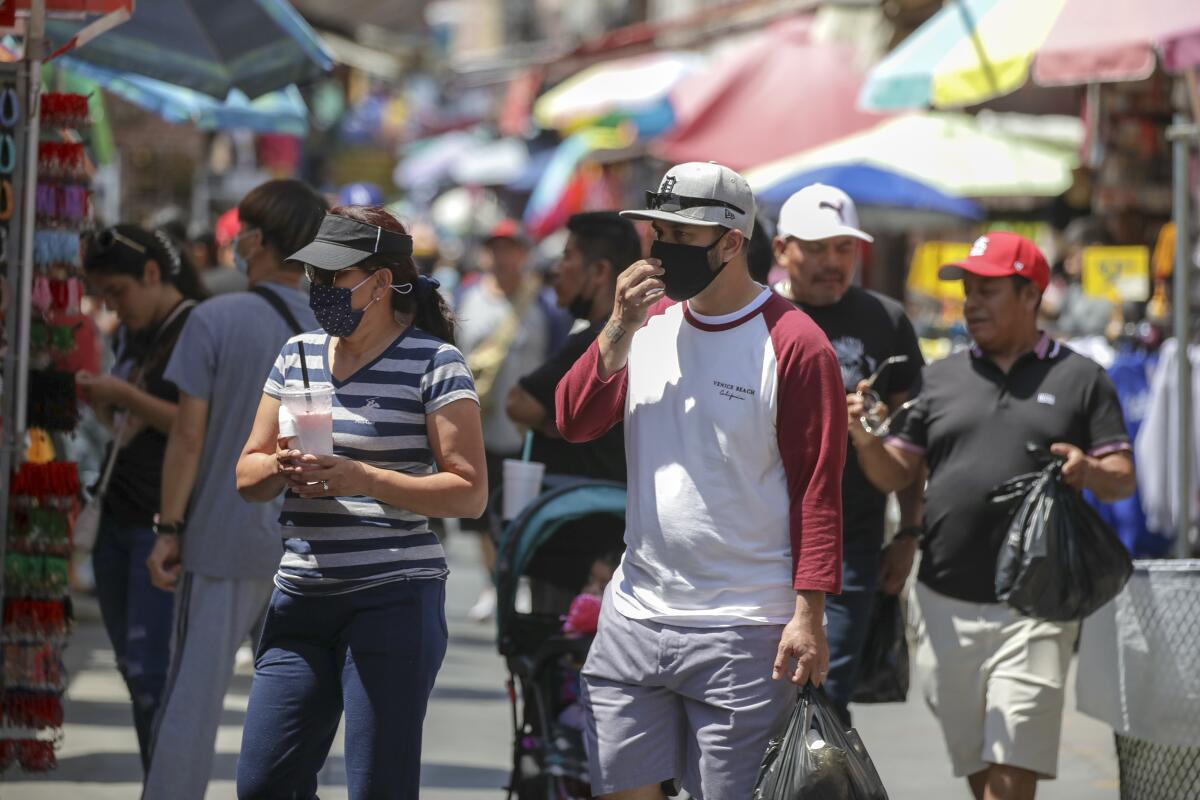
- Share via
The summer coronavirus wave in Los Angeles County — fueled by super-contagious Omicron subvariants — appears to be cresting as cases continue to fall, but the picture is far from good.
COVID-19 deaths — the result of weeks of substantial transmission — remain on the rise and aren’t likely to decrease for some time. Moreover, cases remain highly elevated.
The latest data extend the trends health officials noted last week, when they canceled implementation of a long-looming mask mandate. And while the pandemic has regularly upended prognostications, metrics are moving in a promising direction almost across the board.
“Although we had three instances earlier in the spring and summer where we saw dips in cases that, unfortunately, were followed shortly by increases, this decline is more pronounced, and it’s accompanied by decreases in our other metrics,” county Public Health Director Barbara Ferrer said Tuesday.
Los Angeles County will not reinstitute a universal indoor public mask mandate after marked improvements in the region’s coronavirus case and hospitalization rates.
Over the week ending Wednesday, the nation’s most populous county tallied an average of 5,200 new coronavirus infections per day, down 24% from mid-July — the apparent peak of summer’s surge. It’s “the largest drop in average case counts that we’ve seen since the end of the winter surge,” Ferrer told the county Board of Supervisors.
On a per capita basis, L.A. County is reporting 363 new cases a week for every 100,000 residents, down 15% from the prior week. A rate of 100 or more is considered high.
The downward trend is evident across California, which is reporting 287 cases a week for every 100,000 residents, a 14% week-over-week decrease. The San Francisco Bay Area is reporting 256 cases a week for every 100,000 residents, a 10% decrease from the prior week. And Orange County is reporting 229 cases a week for every 100,000 residents, down 19% over the past week.
L.A. County’s weekly test positivity — the proportion of conducted and reported tests confirming coronavirus infection — also dipped from 15% a week ago to 13.7% Wednesday, officials said. The number of new coronavirus outbreaks reported at worksites, nursing homes and homeless settings have all also declined.
For now, indoor masks remain strongly encouraged but not mandatory in most places.
Hospitals, which have not been nearly as stressed as they were during the pandemic’s previous waves, have also begun to see some relief. As of Tuesday, 1,273 coronavirus-positive patients were hospitalized countywide, down about 4% from last month’s peak, recorded on July 20.
The share of emergency department visits associated with people seeking care for COVID-related symptoms has also fallen.
That’s not to say that the still-widespread community transmission isn’t having an impact, however.
“While the number of patients hospitalized for COVID are not currently putting strain on the DHS hospitals’ overall census, we are quite busy in the emergency departments and urgent cares and are continuing to experience a number of call-offs among staff that are COVID positive and following isolation protocols,” said Dr. Nina Park, chief deputy director of population health at the county Department of Health Services, which runs four public hospitals.
However, she added that the “latest test positivity rate and workforce member testing has decreased slightly over the last two weeks, which we hope to be a continuing trend.”
One major metric still not heading in the right direction, however, is deaths. Over the last week, L.A. County reported 116 COVID-19 fatalities, a 7% increase from a week ago.
“Since deaths always lag behind cases and hospitalizations, we are hopeful that the recent declines in cases and hospitalizations will bring declines in deaths in a few weeks,” Ferrer said. “Every death is heartbreaking.”
The number of coronavirus-positive patients in L.A. County’s intensive care units has not yet seen a sustained downward trend, though the figure remains low overall. There were 138 such patients as of Tuesday, roughly the same as the prior week.
One reason for the recent downturn in infections could be that, eight months into the rapidly evolving Omicron era, the coronavirus may have stabilized.
Since late April, three different Omicron subvariants — BA.2, BA.2.12.1 and BA.5 — have, at times, been the most common version of the coronavirus circulating nationwide.
It’s the last one that now has a stranglehold on viral transmission. According to the U.S. Centers for Disease Control and Prevention, BA.5 made up an estimated 85.5% of new cases for the week ending Saturday.
Emerging evidence suggests that catching the coronavirus a second time can heighten long-term health risks.
Given its dominance and transmissibility, it’s possible BA.5 is simply running out of people to infect. And unlike earlier phases of this most recent wave — which were dominated by the BA.2 and BA.2.12.1 subvariants that transitioned directly into BA.5 — there appears to be no readily visible successor on the horizon.
Still, there is uncertainty.
At a briefing Thursday, Ferrer said she had talked with state officials about whether BA.5 has run its course and has fewer people to infect.
The answers were unclear: “The models are all over the place. Some of the models that the state shared with us showed a little bit of an increase or some plateauing,” Ferrer said.
Sequencing data determining the dominant variants for a given week is typically delayed, and so “we’re always kind of behind on recognizing how much spread BA.5 has been causing or has been responsible for,” she added.
“One thing is for sure: It’s really crowding out everything else, clearly, both here and across the nation. Whether it’s run out of people to infect, I don’t know that we can tell that for certain,” Ferrer said.
COVID-19 safety measures will mirror county requirements, a step back from more aggressive protocols on testing, masking and vaccinations.
BA.5 has been the source of so much worry among public health officials because of its ability to reinfect those who had previously come down with an earlier Omicron strain.
It’s too soon to say for certain that the worst is behind L.A. County. But should recent trends continue, it would mean that the region was able to navigate the pandemic’s latest wave without resorting to the reimposition of universal indoor masking restrictions ordered by county officials.
Some businesses and institutions have decided on their own to impose restrictions, such as canceling large gatherings, moving events outdoors and instituting mask requirements.
Indoor requirements have been in place this summer at UCLA and in the TV and film industry in the L.A. area. The Television Critics Assn. shifted its in-person summer tour to virtual sessions, citing rising case rates while noting that “shows in production cannot or do not want to break COVID bubbles” and “producers, writers, talent and publicists are not willing to appear in person.”
Many officials have said the one-two punch of vaccines and widely available treatments, along with general changes in the nature of the coronavirus itself, had rendered most infections relatively mild and lessened the urgency for strict public health measures.
As the pandemic drags on, cleaning up indoor air has become a passion project not just for aerosol scientists and epidemiologists, but for citizens.
Only one California county, Alameda, instituted a new public indoor mask mandate in response to rising infections this spring, but that measure was short-lived. L.A. County came close to reviving its mask requirements but decided not to after seeing enough improvement in its pandemic metrics last week
Residents should still protect themselves, officials said. It is still strongly encouraged that masks be worn in public indoor spaces. BA.5 remains highly infectious, and in a group of 50 people, there’s a 60% to 70% likelihood that someone in that group is infected, Ferrer has said.
“While we’re relieved with the steady improvements in the county metrics, transmission does remain significantly elevated ... and that means that there is considerable risk of viral spread,” Ferrer said. “Being cautious and layering in protections such as testing before gathering, isolating away from others when infected or sick and masking indoors will continue to slow transmission.”
As the BA.5 subvariant has driven up coronavirus infections in L.A. County, contact tracers are only reaching a fraction of reported cases.
Unvaccinated people in L.A. County are twice as likely to test positive for the coronavirus compared to people who have completed their primary vaccination series, according to figures presented Tuesday. They are also four times as likely to be hospitalized, and six times as likely to die, compared to those who have finished their primary vaccination series.
“Getting vaccinated and boosted remains a critical tool for staying as safe as possible, especially when transmission is so high,” Ferrer said.
More to Read
Sign up for Essential California
The most important California stories and recommendations in your inbox every morning.
You may occasionally receive promotional content from the Los Angeles Times.
